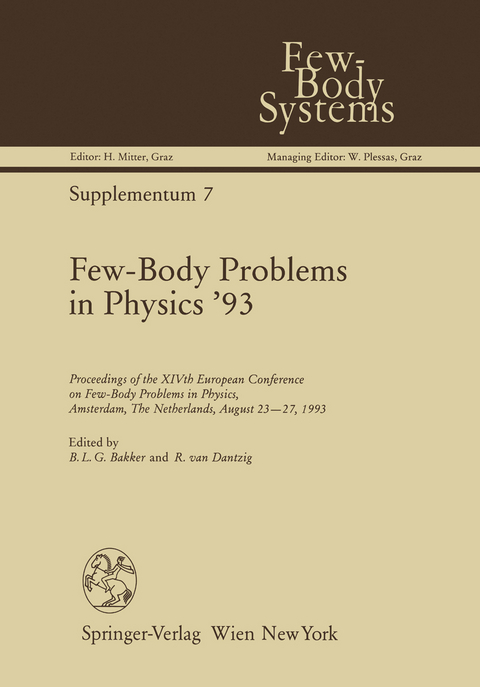
Few-Body Problems in Physics ’93
Springer Wien (Verlag)
9783709193549 (ISBN)
Session 1.- Baryon-baryon interactions.- Precise measurements of spin observables in nucleon-nucleon scattering.- Session 2.- Production of antihyperon-hyperon pairs at LEAR.- Antiproton-proton partial-wave analysis below 925 MeV/c.- Session 3.- Spin observables and annihilation in antiproton-proton reactions.- The nucleon-nucleon interaction and violation of fundamental symmetries.- Status of the Virginia Tech Partial-Wave Analyses.- Session 4.- Periodic orbits and recurrences: an introduction and review.- Nuclear aspects of few-baryon physics.- Session 5.- Electromagnetic form factors of two-nucleon and three-nucleon bound states.- Electron scattering with polarized 3He targets.- Reactions of polarised electrons on D and 3He.- Session 6.- Electron scattering from polarised deuterium at VEPP-3.- Results of (e,e'x) studies on 4He.- Separation of electromagnetic response functions of few-body nuclei in (e,e'p) reactions.- Session 7.- A Simultaneous measurement of the (?,n) and (?,p) reactions in 4He.- Electrodisintegration of the deuteron.- Exclusive electron scattering from deuterium at high Q2.- Session 8.- Recent advances in the quantum theory of chemical reaction rates 2.- Proton-deuteron break-up including Coulomb effects.- Session 9.- Structure and fragmentation of few-body atomic systems.- Recent developments on the four-nucleon frontier.- Photo-induced reactions on 4He.- Session 10.- Nuclear transitions in muonic molecules.- Theory of formation and decay of metastable states of hadronic helium atoms.- Signature of a narrow ?NN-resonance in the energy dependence of the pionic double charge exchange.- Exotic dibaryons correlated with experiment.- Alpha-particle binding energies for realistic nucleon-nucleon interactions.- Session 11.- Recent results from thenucleon-nucleon program at SATURNE II.- Measurement of the np?pp?- at 443 MeV.- A gauge invariant unitary theory for pion photoproduction.- The ?d??r0d and ?d?pn reactions in the ?-resonance region.- Final-state interaction effects in the coupled-channel NN-N? approach of the ?NN System.- Session 12.- Cross section and analyzing power Ay in the proton induced deuteron breakup reaction at 65 MeV.- Meson production near threshold via the reaction p+d?3He+X.- Influence of isobars on deuteron electric stucture function A(q2).- Tensor and vector analyzing powers in the reaction 2H(e,e'p).- Outgoing nucleon polarization in exclusive deuteron electrodisintegration.- Trinucleon threshold electrodisintegration.- Session 13.- Solving Faddeev equations in the interaction domain.- Cluster-dynamical treatment of three-nucleon forces.- Variational calculations for scattering states in few-nucleon systems.- Relativistic meson spectroscopy in momentum space.- Relativistic two-body bound-state calculations beyond the ladder approximation.- A relativistic constituent quark model.- Session 14.- Convolution approach to the ?NN system.- Pionic hydrogen and the low energy ?N-interaction.- The E2/M1 mixing ratio in the excitation of the ? from polarized photo-reactions.- Session 15.- Pion photoproduction on the nucleon and light nuclei.- Pion absorption in tritium and helium.- Session 16.- Monte Carlo studies of light nuclei: structure and response.- Numerical methods in configuration-space A=3,4 bound-state and scattering calculations.- Hyperspherical approach to ultra-precise nonvariational calculations in the few-body problem.- Session 17.- The role of two-body interactions in the description of few and many-nucleon systems.- Stability of Hierarchical Triple Stars.-Session 18.- Relativistic quasipotential approaches and electromagnetic form factors of the deuteron.- Relativistic effects in $$qbar q$$ systems.- Charmonium spectroscopy with antiprotons.- Session 19.- Quarks in few hadron systems.- Pions and neutrinos as probes of the nucleon and nuclear few-body systems.- Session 20.- Spin-structure function of the neutron (3He): SLAC results.- The spin-dependent structure function of the deuteron.- Inclusive quasielastic and deep inelastic scattering of polarized electrons by polarized 3He.
| Erscheint lt. Verlag | 22.1.2012 |
|---|---|
| Reihe/Serie | Few-Body Systems |
| Zusatzinfo | XV, 486 p. |
| Verlagsort | Vienna |
| Sprache | englisch |
| Maße | 170 x 244 mm |
| Gewicht | 866 g |
| Themenwelt | Naturwissenschaften ► Physik / Astronomie ► Atom- / Kern- / Molekularphysik |
| Naturwissenschaften ► Physik / Astronomie ► Hochenergiephysik / Teilchenphysik | |
| Naturwissenschaften ► Physik / Astronomie ► Quantenphysik | |
| Naturwissenschaften ► Physik / Astronomie ► Theoretische Physik | |
| Schlagworte | Baryon • Hadron • Meson • molecular physics • nuclear physics • Quark |
| ISBN-13 | 9783709193549 / 9783709193549 |
| Zustand | Neuware |
| Informationen gemäß Produktsicherheitsverordnung (GPSR) | |
| Haben Sie eine Frage zum Produkt? |
aus dem Bereich


